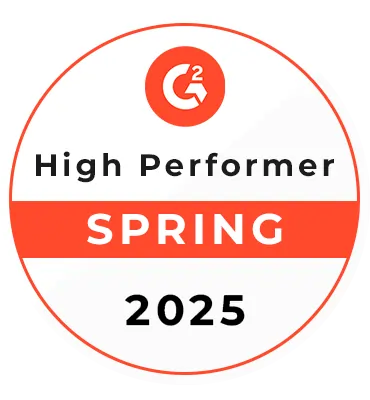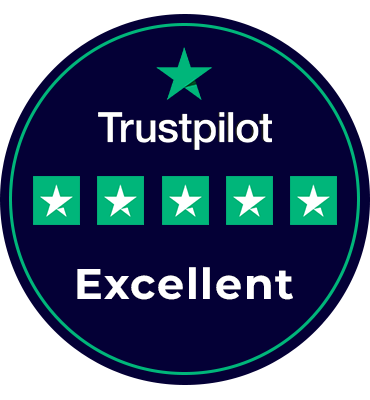Optimizing Production Costs Effective Strategies For Manufacturers
Manish kumawat
Last Updated on: 29 September 2025
As you know, the manufacturing process is costly. Between buying raw materials, paying workers, and keeping the lights on, a lot of money goes out. That’s why manufacturing industry owners are under constant pressure to cut costs while maintaining or improving product quality. But how is it possible to have both simultaneously?
Tons of manufacturers are trying to figure out how to save cash without sacrificing quality. Don't worry, here we are going to introduce a secret tool for you to achieve both cost reduction and premium quality.
Cost optimization is relevant not only for manufacturing businesses but also for all businesses. This guide is all about finding those ideal ways to trim costs without losing quality. We'll talk about everything from squeezing more out of your materials to making your factory run like a profitable machine.
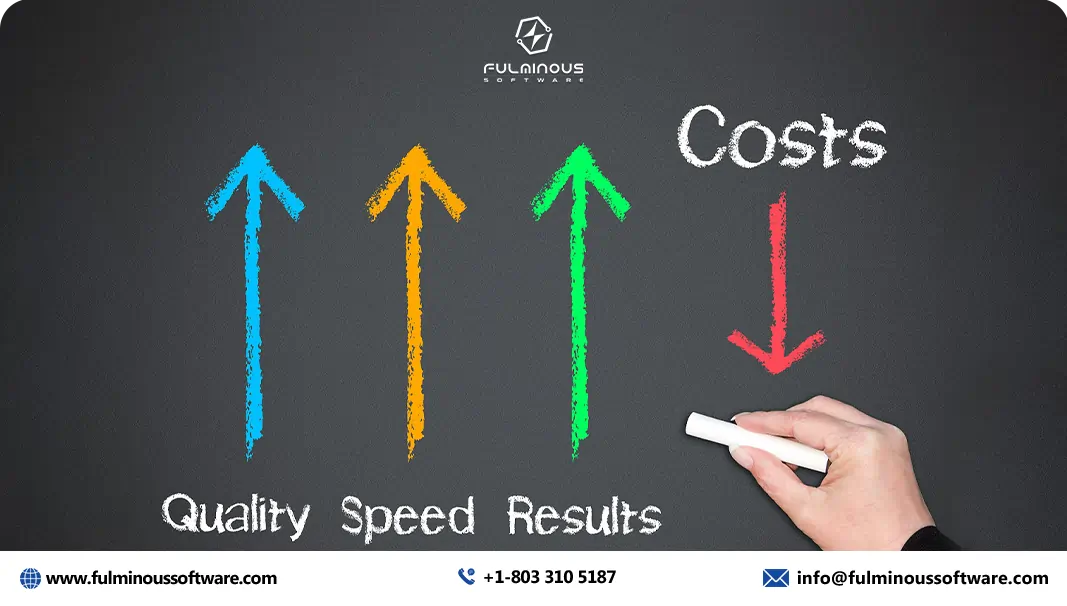
So, if you're ready, let's have a beneficial reading journey!
Understanding Cost Optimization for Manufacturers
Cost optimization in manufacturing is the art of squeezing more out of every dollar spent. It's about seeking ways to reduce manufacturing expenses without compromising product quality. It is vital for manufacturing businesses to optimize their costs so that they can maintain profitability and stay competitive in today's market. Cost optimization is a critical component of a successful manufacturing operation. It involves identifying, analyzing, and reducing expenses without compromising product quality or customer satisfaction.
See the Important Areas of Cost Optimization in Manufacturing
Before getting into various strategies for manufacturing cost optimization, we need to understand its various aspects.

1. Material Costs
- Supplier optimization: Building strong relationships with suppliers can lead to better pricing, improved quality, and timely deliveries.
- Material substitution: Look for substitute materials to cut expenses without sacrificing the quality of the product.
- Waste reduction: Material waste can be reduced by putting lean manufacturing ideas and recycling initiatives into practice.
- Inventory management: Effective management of inventory prevents stockouts and overstocking, thereby lowering carrying costs.
2. Labor Costs
- Workforce optimization: It is possible to find opportunities for improvement by analyzing labor expenses and productivity.
- Automation: Implementing automation technologies can reduce labor-intensive tasks and increase efficiency.
- Employee training: Investing in employee training can enhance skills and productivity.
- Flexible workforce: Implementing flexible work arrangements can optimize labor costs based on production demands.
3. Energy Costs
- Energy efficiency: The amount of energy used can be greatly decreased by identifying and putting into practice energy-saving techniques.
- Equipment optimization: Operating costs can be reduced by switching to more energy-efficient equipment.
- Demand response: Taking part in demand response initiatives can assist with energy cost management.
4. Overhead Costs
- Facility optimization: Cost-saving options can be found by analyzing the design and usage of the facility.
- Technology adoption: Leveraging technology to streamline processes can reduce overhead costs.
- Outsourcing: Reducing overhead costs can be achieved by determining which tasks can be outsourced.
Why Optimizing Production Costs is Crucial for Manufacturers
In today’s highly competitive manufacturing landscape, optimizing production costs is no longer a luxury but a necessity for survival and growth. Every dollar saved directly impacts a manufacturer's bottom line, enhancing profitability and enabling reinvestment in research, development, and innovation.
The Consequences of Ignoring Cost Optimization
The first concern is what will happen if I don’t implement these cost optimization tips. Failing to optimize production costs can have severe repercussions for manufacturers:
- Reduced competitiveness: Higher production costs can lead to price increases, making products less attractive to customers.
- Decreased profitability: Increased costs erode profit margins, limiting the company's ability to invest in growth and development.
- Financial instability: Cash flow issues can arise due to higher expenses, impacting the company's overall financial health.
- Loss of market share: Unable to compete on price or value, manufacturers may lose market share to more cost-effective competitors.
- Stalled growth: Limited financial resources hinder the company's ability to expand, introduce new products, or enter new markets.
The Impact of Production Cost Optimization
The second concern is what are the benefits if I implement these cost optimization tips. Many expenses are included in production costs, such as labor, energy, overhead, raw materials, and equipment. Even small reductions in cost can provide substantial savings over time. Moreover, cost optimization is interconnected with other critical business functions:
- Price competitiveness: Lower production costs allow manufacturers to offer competitive prices without sacrificing profit margins.
- Profitability: Reduced costs directly translate into higher profit margins. This increased profitability can be reinvested in business growth, product development, and employee welfare.
- Cash flow: Cash flow can be increased by efficient cost management that also reduces expenses and optimizes working capital.
- Investment in technology: Savings from cost optimization can be allocated towards adopting advanced technologies and automation, enhancing productivity and efficiency.
- Customer satisfaction: By delivering products at competitive prices, manufacturers can increase customer satisfaction and loyalty.
- Sustainability: Cost optimization often involves reducing waste and energy consumption, contributing to environmental sustainability and corporate social responsibility.
Both statements confirm that cost optimization is not an option if you're looking for business growth. But you need a set of proven strategies to implement it successfully.
Common Strategies for Manufacturing Cost Optimization
Manufacturers can use the following solutions to effectively cut costs:
- Cost benchmarking: Comparing costs to industry standards can identify areas for improvement.
- Value engineering: Analyzing product components to identify cost-saving opportunities without compromising functionality.
- Lean manufacturing: Use lean concepts to cut waste and boost productivity.
- Total Quality Management (TQM): Focusing on quality improvement to reduce defects and rework costs.
- Supply chain optimization: Streamlining the supply chain to reduce transportation, inventory, and procurement costs.
- Data analytics: Utilizing data to identify cost trends and patterns.
- Continuous improvement: Encouraging a culture of ongoing development in order to find and execute cost-cutting measures.
Understanding the Manufacturing Cost Optimization Challenge
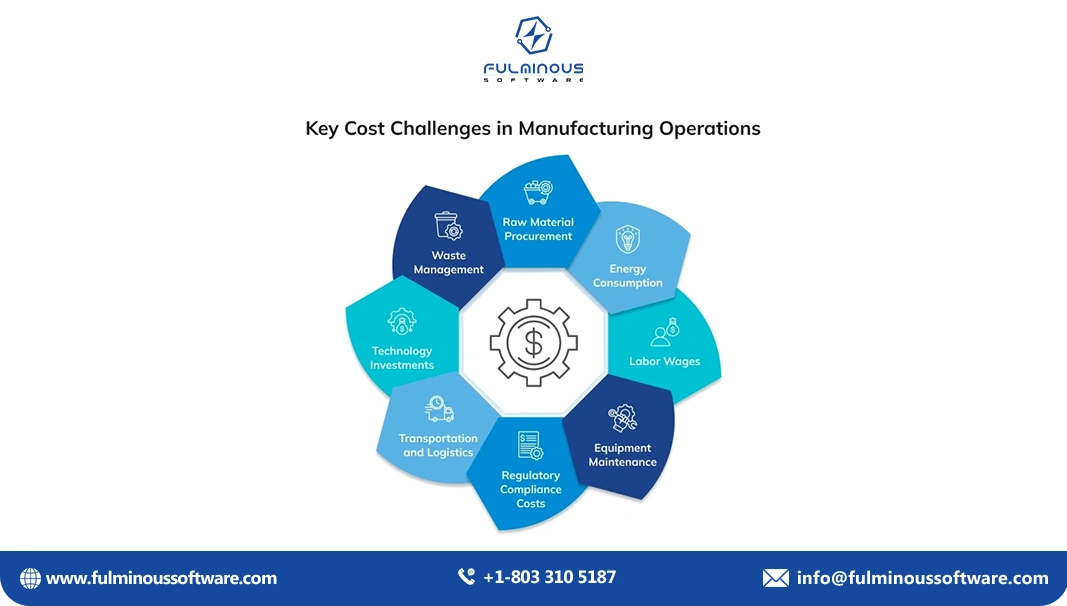
While cost optimization offers significant benefits, manufacturers face several challenges:
- Balancing cost with quality: Reducing costs should not compromise product quality or customer satisfaction.
- Employee resistance: Implementing changes can lead to resistance from employees.
- Initial investment: Some cost-saving initiatives require upfront investments.
- Market fluctuations: External factors like economic conditions and material prices can impact.
- Material Costs: The price of materials keeps going up.
- Worker Pay: Paying people enough to stay and do a good job is tough.
- Energy Bills: The cost of electricity and gas is killing us.
- Overhead Costs: Rent, insurance, and other bills just keep piling up.
- Supplier Issues: Dealing with unreliable suppliers is a nightmare.
- New Technology: Buying new machines and software is expensive.
- Quality Control: Making sure everything is perfect without spending a fortune.
- Waste: Throwing things away costs money and is bad for the planet.
- Price Wars: Customers always want things cheaper.
- Keeping Up: Competitors are always finding new ways to save money.
The Ideal Tool: Optimizing Manufacturing Costs with IoT
As an experienced businessman, you may ask why IoT? What IIoT can do differently from other trending technologies. The clarification for your concern is given below with real-life success stories.
1. Material Costs Optimization with IoT
Material costs are a significant component of manufacturing expenses. IoT can help optimize these costs by:
- Real-time inventory tracking: Sensors can monitor inventory levels, preventing stockouts and overstocking. Ensure optimal inventory levels and reduce carrying costs.
- Supply chain visibility: IoT devices can track the movement of materials throughout the supply chain, identifying bottlenecks and inefficiencies. Optimize transportation routes, reduce lead times, and negotiate better deals with suppliers.
- Quality control: Sensors can monitor material quality during the production process, reducing waste due to defective materials. Minimize rework and scrap costs.
Case Study: Rolls-Royce
Scenario: Rolls-Royce, a leading manufacturer of aircraft engines, faced challenges with inventory management and supply chain visibility.
Implementation:
- Rolls-Royce implemented IoT sensors to monitor inventory levels in real-time.
- By integrating IoT devices across their supply chain, Rolls-Royce tracked the movement of materials from suppliers to production lines.
- IoT sensors were deployed to monitor material quality during production.
Results: Rolls-Royce achieved significant cost savings in inventory management and improved supply chain efficiency, leading to better overall operational performance.
2. Labor Costs Optimization with IoT
IoT can enhance labor productivity and efficiency, leading to reduced labor costs:
- Predictive maintenance: IoT sensors can monitor equipment health, enabling predictive maintenance. This minimizes unplanned downtime, avoiding disruptions to production schedules and increases in labor costs.
- Worker safety: Wearable IoT devices can monitor worker safety conditions, reducing accidents and associated costs.
- Ergonomics: By analyzing worker movements and postures, IoT can identify ergonomic issues, reducing injuries and improving worker productivity.
- Performance tracking: IoT can track employee performance metrics, providing insights into productivity and identifying training needs.
Case Study: Siemens
Scenario: Siemens, a global industrial manufacturing company, sought to enhance labor productivity and efficiency in their factories.
Implementation:
- Siemens used IoT sensors to monitor the health of their equipment. Predictive maintenance schedules were created based on sensor data, minimizing unplanned downtime and reducing labor costs associated with emergency repairs.
- Wearable IoT devices were introduced to monitor worker safety conditions, such as exposure to hazardous materials or extreme temperatures. This proactive approach reduced workplace accidents and associated costs.
- Siemens analyzed data from IoT devices to identify ergonomic issues in worker movements and postures. Addressing these issues reduced injuries and improved worker productivity.
- IoT systems tracked employee performance metrics, providing insights into productivity levels and identifying areas for training and improvement.
Results: Siemens saw a reduction in labor costs due to fewer accidents, optimized maintenance schedules, and improved worker productivity.
3. Energy Costs Optimization with IoT
Energy consumption is a substantial expense for many manufacturers. IoT can help optimize energy usage:
- Energy monitoring: IoT sensors can monitor energy consumption in real-time, identifying areas of high energy usage and reducing overall energy consumption.
- Demand response: IoT-enabled systems can arrange energy consumption depending on real-time pricing, reducing overall energy costs.
- Equipment optimization: IoT can monitor and manage equipment energy consumption, identifying inefficient machines and opportunities for upgrades.
- HVAC optimization: IoT can optimize heating, ventilation, and air conditioning systems based on occupancy and weather conditions.
Case Study: General Electric (GE)
Scenario: General Electric, a major player in various industrial sectors, aimed to reduce its substantial energy expenses.
Implementation:
- GE installed IoT sensors to monitor energy consumption in real-time across their facilities.
- GE's IoT-enabled systems adjusted energy consumption based on real-time pricing, shifting energy usage to off-peak times to reduce costs.
- By monitoring the energy consumption of individual machines, GE identified inefficient equipment and opportunities for upgrades to more energy-efficient models.
- IoT systems optimized heating, ventilation, and air conditioning based on occupancy and weather conditions, reducing unnecessary energy use.
Results: GE achieved significant energy cost savings and improved its overall energy efficiency.
4. Overhead Costs Optimization with IoT
IoT can help reduce overhead costs by streamlining operations and improving efficiency:
- Asset tracking: IoT can track the location and usage of assets, such as tools and equipment, preventing loss and optimizing utilization.
- Facility management: IoT sensors can monitor and manage production based on environmental conditions, optimizing building systems and reducing maintenance costs.
- Process optimization: IoT can offer data on manufacturing processes, identifying bottlenecks and inefficiencies that can be addressed to reduce overhead.
- Security: IoT can enhance security by monitoring access points, detecting anomalies, and reducing the risk of theft and vandalism.
Case Study: Caterpillar Inc.
Scenario: Caterpillar, a leading manufacturer of construction and mining equipment, sought to reduce overhead costs by streamlining operations.
Implementation:
- Utilizing IoT, Caterpillar was able to maximize utilization while reducing loss by tracking the location and usage of tools and equipment.
- IoT sensors monitored environmental conditions such as temperature and humidity in Caterpillar's facilities.
- IoT provided data on production processes, identifying bottlenecks and inefficiencies. Caterpillar used this data to streamline operations and reduce overhead.
- IoT systems enhanced security by monitoring access points and detecting anomalies, reducing the risk of theft and vandalism.
Results: Caterpillar saw a reduction in overhead costs through better asset utilization, improved facility management, optimized processes, and enhanced security.
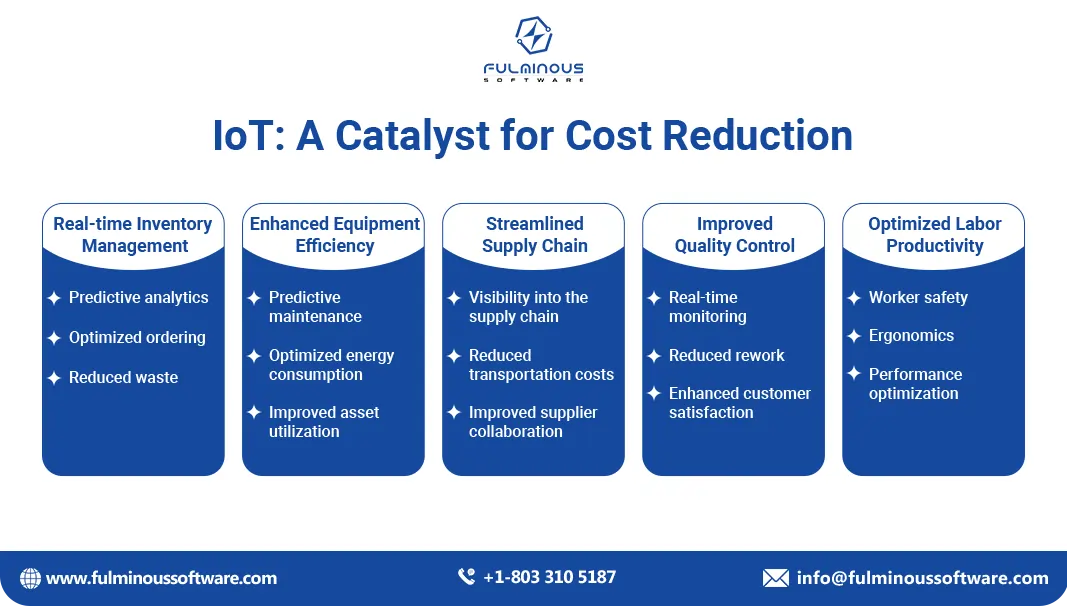
Let’s Implement IoT for Manufacturing Cost Optimization
Yes, we know that after seeing the unmatched benefits of IoT development in manufacturing cost optimization, you are excited to implement IoT as soon as possible. Before going ahead, let's see its important steps:
Implementation Steps
- Identify Key Areas: Pinpoint the areas of your manufacturing process that bleed the most money. Focus on those that promise the biggest cost reductions.
- Data Collection: Strategically place sensors to capture essential data. Make sure your data are consistent and accurate for trustworthy analysis.
- Data Analysis: Use advanced analytics tools to uncover hidden patterns and correlations within your data. Look for opportunities to optimize.
- Pilot Testing: Implement IoT solutions on a small scale to test their effectiveness and identify potential challenges.
- Scalability: Gradually expand the IoT implementation across your entire operation based on successful pilot results.
- Continuous Improvement: Regularly assess IoT performance and make adjustments as needed. Encourage a habit of innovation and experimentation.
Implementation Cost
The cost of implementing IoT for cost optimization can be broken down as follows:
- Hardware: Sensors, gateways, and other devices can add up quickly.
- Software: Platforms for data collection, analysis, and visualization come with a price tag.
- Connectivity: Cellular or Wi-Fi plans for your devices can be ongoing expenses.
- Installation: Setting up hardware and software requires labor or contractor costs.
- Integration: Connecting IoT systems with existing IT infrastructure might need additional resources.
- Data Analysis: Skilled personnel or software for interpreting data can be costly.
- Maintenance: Ongoing upkeep of hardware, software, and network connections.
- Training: Educating employees on IoT concepts and tools.
Implementation Assistance
Partnering with an experienced software service provider with proficiency in IoT Development like Fulminous can significantly streamline the IoT implementation process. Here's how they can help:
- Expertise: They offer deep knowledge of IoT technologies, best practices, and industry-specific solutions.
- Customization: Tailored IoT solutions to match your unique business requirements.
- Hardware and Software Selection: Recommending the right devices and platforms for your needs.
- Integration: Smoothly integrating IoT systems with current IT infrastructure.
- Data Analysis: Providing data analytics tools and expertise to extract valuable insights.
- Implementation Support: Offering technical assistance and project management.
- Training: Empowering your team with the necessary skills to manage the IoT system.
- Maintenance and Support: Ensuring the ongoing performance and reliability of the IoT solution.
By collaborating with tech partners like Fulminous, manufacturers can optimize costs with IoT.
Conclusion
In conclusion, reducing production costs while maintaining or improving product quality is not a big challenge for manufacturers today! IoT will help with that. Implementing IoT in manufacturing is the best move to cut costs and improve efficiency. IoT offers plenty of benefits in reducing expenses related to materials, labor, energy, and overhead.
At the same time, there are several clear steps for successfully implementing IoT. Though there are initial costs and challenges, working with experienced IoT service providers like Fulminous Software can make the process smoother. By adopting IoT, manufacturers can stay competitive, lead in innovation, and satisfy customers.
So, you wanna make your factory awesome without breaking the bank? IoT is the way to go! It's like magic for cutting costs and making things better. Fulminous Software can help you work this IoT thing. We are all set to make it easy and help you crush the competition. Ready to level up your business? Let's chat!
FAQs
Q1. How does IoT help in reducing material costs?
-
A: IoT reduces material costs by enabling real-time inventory tracking, optimizing supply chain management, and ensuring quality control throughout the production process.
- Prevents stockouts and overstocking.
- Identifies supply chain inefficiencies.
- Reduces waste and rework.
Q2. What are the benefits of energy cost optimization with IoT?
-
A: IoT optimizes energy costs by monitoring consumption, implementing demand response, and optimizing equipment and HVAC systems.
- Identifies high energy usage areas.
- Shifts energy use to off-peak times.
- Improves energy efficiency.
Q3. How does IoT enhance quality control?
-
A: IoT enhances quality control by providing real-time monitoring of material quality, reducing defects, and minimizing waste and rework.
- Ensures consistent product quality.
- Detects issues early in production.
- Improves customer satisfaction.
Q4. What are the initial costs of implementing IoT?
-
A: Initial IoT implementation costs include hardware (sensors, gateways), software (platforms), connectivity, installation, integration, and training.
- Hardware and software expenses.
- Installation and integration costs.
- Training for employees.
Q5. Why partner with an IoT service provider?
-
A: Partnering with an IoT service provider offers expertise, customized solutions, and support for smooth implementation and ongoing maintenance.
- Access to industry-specific knowledge.
- Tailored IoT solutions.
- Ongoing support and maintenance.
HIRE A TOP SOFTWARE DEVELOPMENT COMPANY

 Verified
Expert in Software & Web App Engineering
Verified
Expert in Software & Web App Engineering
I am Manish Kumawat, co-founder of Fulminous Software, a top leading customized software design and development company with a global presence in the USA, Australia, UK, and Europe. Over the last 10+ years, I am designing and developing web applications, e-commerce online stores, and software solutions custom tailored according to business industries needs. Being an experienced entrepreneur and research professional my main vision is to enlighten business owners, and worldwide audiences to provide in-depth IT sector knowledge with latest IT trends to grow businesses online.
Partner with Top-Notch Web Application Development Company!
Discuss your Custom Application Requirements on info@fulminoussoftware.com or call us on +1-903 488 7170.
15 Days Risk-Free TrialRecommended Articles

